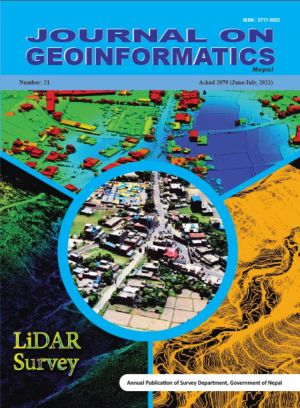Accuracy Assessment of UAV for Cadastral Application
DOI:
https://doi.org/10.3126/njg.v21i1.48745Keywords:
Unmanned Aerial Vehicles, Point clouds, Orthomosaic, Digital Elevation Model, Digital Terrain ModelAbstract
This study aims to produce accurate geospatial 3D data from unmanned aerial vehicle (UAV) images. An image of approx. 1 km2 area of the Banepa-10, Kabhrepalanchok district was captured using a DJI Mavic Pro drone. Pix4dmapper programs were used to generate the solution. The horizontal and vertical accuracies of the obtained UAV solution were computed by comparing the coordinates of 5 Ground Control Points (GCPs) with coordinates measured using the static DGPS observation method. The root mean square error (RMSE) was calculated during geo-referencing of Orthomosaic and obtained a value of 0.006.Mainly, three comparisons were made for parcels digitized from the Orthomosaic image w.r.t to Total Station and Tape measurement ; Area, Perimeter and Centroid Position. Cadastral survey using Total station, UAV and Tape measurement were confirmed to be comparable in terms of accuracy, completeness, and expenditure of time. From the result of this study, the area as well perimeter of parcels obtained from georeferenced orthorectified UAV image seems to be closer with the area as well as perimeter from total station survey compared to those obtained from tape measurement. If the area is pre-demarcated and clearly visible in Orthomosaic image, then information can efficiently be gained. Some ambiguity could be seen in the comparison of digitized parcels whose boundary information was not clear.




